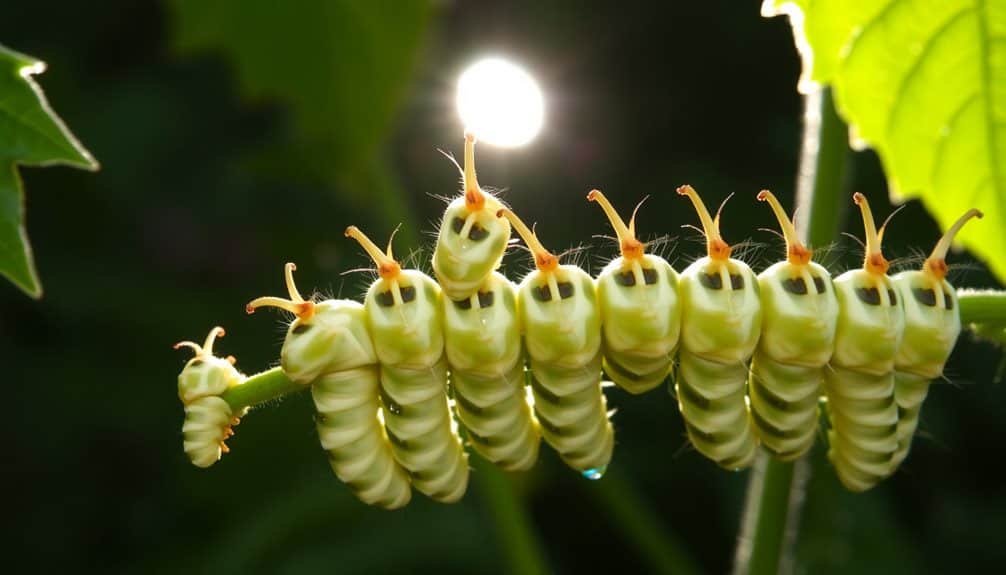This website contains affiliate links. Some products are gifted by the brand to test. As an Amazon Associate, I earn from qualifying purchases. The content on this website was created with the help of AI.
You'll need to focus on key identifying features during each pest's developmental stage to effectively control garden infestations. Common pests like butterflies, moths, and beetles undergo complete metamorphosis through egg, larva, pupa, and adult phases, while aphids display incomplete metamorphosis with egg, nymph, and adult stages. Each phase exhibits distinct visual markers – from silk threads and frass patterns to specific body segmentations and wing structures. Understanding these growth patterns, along with monitoring insect activity periods and recognizing beneficial versus harmful species, will strengthen your integrated pest management approach. The following guide reveals critical identification techniques for precise pest classification.
Key Takeaways
- Observe insect body structure changes through developmental stages, including egg clusters, larvae/nymphs, pupae, and adult forms.
- Look for characteristic feeding damage patterns, such as clean-cut stems from cutworms or holes from caterpillars.
- Monitor pest activities during different times, as specific insects are more active during certain daylight periods.
- Document wing patterns, body segmentation, and mouthpart types to distinguish between beneficial and harmful garden insects.
- Track metamorphosis stages through visual markers like head capsule size, color changes, and specialized anatomical features.
Common Butterfly and Moth Pests

Butterfly and moth pests frequently damage garden plants during their larval stages, when caterpillars feed voraciously on leaves, stems, and fruits. You'll find cabbage white butterflies (Pieris rapae) targeting brassicas, while tomato hornworms (Manduca quinquemaculata) devastate nightshade family plants. The distinctive yellow-and-black striped monarch caterpillar (Danaus plexippus) specifically targets milkweed species.
In the moth family, you'll encounter codling moths (Cydia pomonella) that bore into apples and pears, and cutworms (Noctuidae family) that sever young plant stems at soil level. The fall armyworm (Spodoptera frugiperda) moves in masses across crops, while tent caterpillars (Malacosoma species) construct protective silk nests in tree branches.
To identify these pests accurately, you'll need to examine their specific feeding patterns and morphological characteristics. Look for silk threads, frass deposits, and characteristic leaf damage patterns. Cabbage loopers (Trichoplusia ni) create distinctive holes in leaves, while gypsy moth caterpillars (Lymantria dispar) completely defoliate trees. The presence of cocoons, egg masses, or adult moths near damaged plants provides additional identification clues.
Beetles Through Their Life Cycles
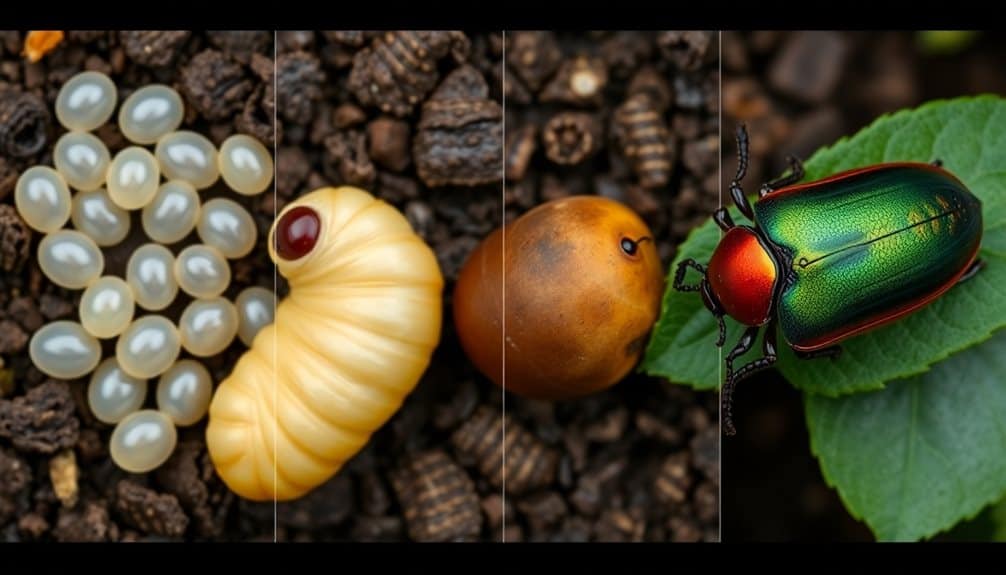
A beetle's complete metamorphosis progresses through four distinct life stages: egg, larva, pupa, and adult (imago). You'll find beetle eggs in clusters beneath leaves, within soil, or inside plant tissue, varying in color from white to yellow. The eggs typically hatch within 7-10 days under ideal conditions.
The larval stage, often called grubs, presents the most destructive phase of a beetle's life cycle. You'll recognize these C-shaped, soft-bodied creatures by their distinct head capsules and three pairs of thoracic legs. Common garden pests like Japanese beetles spend 9-12 months as larvae, feeding on plant roots.
During pupation, you'll observe the transformation within earthen cells or cocoons. The beetle's body undergoes significant reorganization, developing adult features over 2-3 weeks. External appendages become visible through the pupal casing.
The adult stage emerges with hardened wing covers (elytra) and functional wings. You can identify adult beetles by their characteristic chewing mouthparts, segmented antennae, and modified forewings. Adults continue causing plant damage through defoliation, boring, or fruit feeding, completing their 1-3 year life cycle.
Understanding Aphid Development Stages
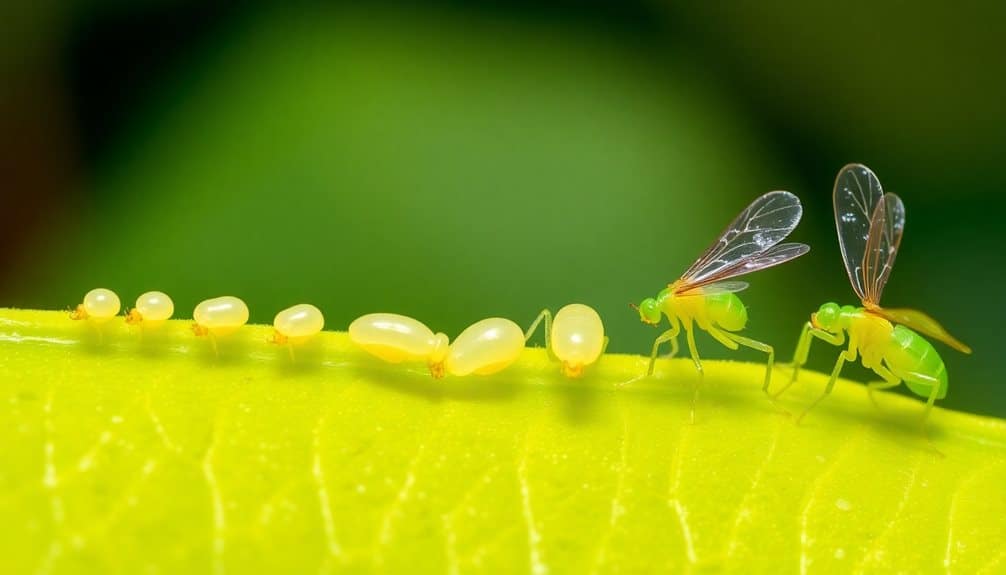
Unlike beetles, most aphids demonstrate incomplete metamorphosis through three primary developmental stages: egg, nymph (instar), and adult. You'll typically observe overwintering eggs on host plants during dormant seasons, though some species can reproduce parthenogenetically, skipping the egg stage entirely.
When monitoring your garden for aphid development, you'll notice these key characteristics:
- Nymphs (instars) emerge as smaller versions of adults, molting 4-5 times while retaining similar body structure throughout development
- Wingless adults predominate during favorable conditions, while winged morphs appear when populations become crowded or environmental stress occurs
- Parthenogenic females can produce 50-100 offspring within a week, leading to rapid population expansion
The nymphal stages progress rapidly, often completing development within 7-10 days under ideal conditions. You'll observe that each successive instar increases in size while maintaining the species-specific coloration patterns. Adult aphids measure 1-4mm in length, with distinctive cornicles on their posterior. These structures secrete alarm pheromones when predators threaten the colony, triggering defensive responses throughout the population.
Cutworm Growth and Identification
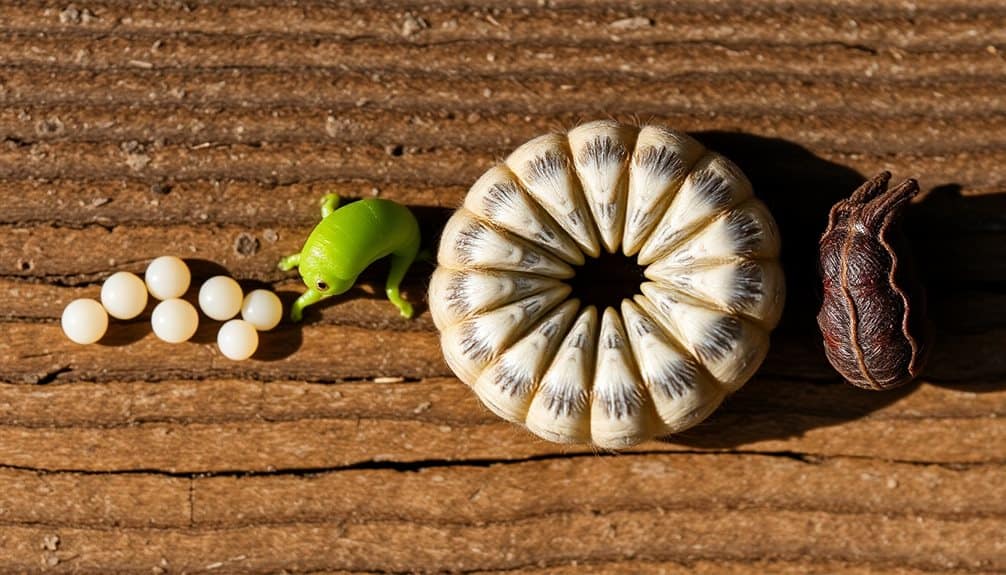
While aphids pose challenges through rapid reproduction, cutworms present a different threat through their nocturnal feeding habits and distinct growth cycle. You'll find these destructive larvae most active during spring, when they emerge from overwintered eggs. The cutworm's life cycle progresses through six distinct instars, spanning 3-4 weeks.
You can identify early-stage cutworms by their 1/4-inch length and translucent gray coloring. As they mature, they'll develop distinctive markings: spots, stripes, or geometric patterns specific to their species. By the fifth instar, you'll observe them reaching 1.5-2 inches in length, with colors ranging from brown to black.
When examining your garden, look for their characteristic C-shaped curling position when disturbed. You'll notice that mature cutworms possess a robust, cylindrical body form and a prominent head capsule. During daylight hours, you'll find them buried 1-2 inches beneath the soil surface near damaged plants. Their feeding damage appears as clean-cut stems at soil level, distinguishing them from other garden pests that cause irregular plant damage.
Recognizing Caterpillar Species and Stages

Proper caterpillar identification relies on recognizing key morphological features across their developmental stages. You'll need to examine specific anatomical characteristics, including the number of prolegs, presence of hair patterns, and distinctive markings that distinguish different species. Understanding the instar phases helps you track their development from egg to adult.
Key identification markers you'll encounter include:
- Head capsule size and coloration, which changes between molts and varies by species
- Segmental patterns and tubercles, particularly on the thoracic and abdominal regions
- Specialized structures like osmeterium in swallowtail caterpillars or urticating hairs in specific moth species
When you're examining specimens, focus on the arrangement of setae (body hairs), presence of lateral lines, and distinctive colorations that emerge during different instars. Most lepidopteran larvae progress through 4-5 instars, with each stage displaying unique characteristics. You'll notice that final instars often exhibit the most definitive species-specific features, making this stage ideal for accurate identification. Document size measurements and behavioral traits, as these can provide additional confirmation of species classification.
Garden Slug Development Patterns

Garden slugs undergo a complex developmental sequence that you'll observe through distinct growth phases, beginning with egg clusters in moist soil environments. You'll find these translucent, pearl-like eggs in clutches of 20-100, typically deposited beneath leaves or in soil cavities. The eggs develop over 2-4 weeks, depending on environmental conditions and species.
When you're monitoring slug development, you'll notice newly hatched juveniles emerge at approximately 4mm in length, displaying a pale, semi-transparent appearance. These immature slugs will rapidly progress through five growth stages, each marked by incremental size increases and intensifying pigmentation. You'll observe them reaching maturity within 3-6 months.
As you track their development, you'll see mature slugs exhibiting species-specific characteristics: distinctive mantle patterns, variable tentacle lengths, and specialized foot structures. Most garden slug species you'll encounter reach adult lengths of 2-10cm. During this stage, you'll notice increased mucus production, territorial behaviors, and reproductive maturity. Each slug's life cycle typically spans 12-18 months, though you'll find this varies based on species and environmental factors.
Identifying Beneficial Versus Harmful Insects
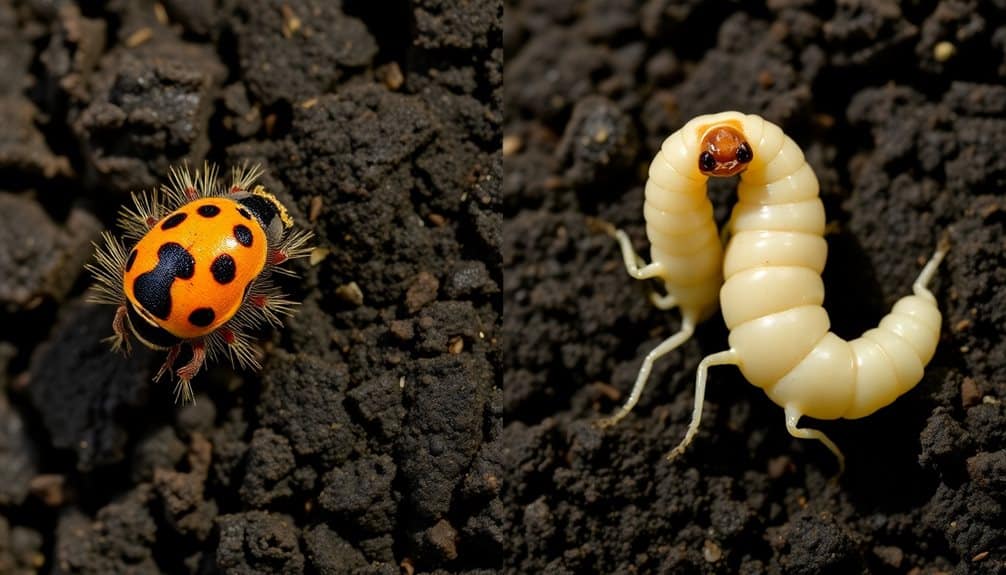
Distinguishing between beneficial and harmful insects requires systematic observation of key morphological features and behavioral patterns. You'll need to assess wing structure, mouthpart configuration, and movement patterns to make accurate identifications. Most beneficial insects display specialized anatomical features that support their predatory or pollinating roles.
When you're examining garden insects, focus on these critical identifiers:
- Predatory insects (beneficial) typically exhibit prominent compound eyes, raptorial forelegs, or elongated ovipositors, like those found in parasitic wasps and mantids
- Plant-feeding insects (potentially harmful) often show specialized chewing mouthparts, piercing-sucking structures, or pronounced mandibles for tissue consumption
- Pollinator species (beneficial) characteristically display branched body hairs, pollen baskets, or extended proboscises for nectar collection
You'll find that beneficial insects generally demonstrate quick, deliberate movements while hunting or pollinating, whereas harmful pests tend to exhibit slower, sustained feeding behaviors on plant tissues. Monitor insect activity during different daylight periods, as timing often correlates with their ecological role. Document wing patterns, body segmentation, and antennae structure to build your identification expertise.
Frequently Asked Questions
How Long Should I Wait Before Replanting After Removing Pest-Infected Plants?
Like turning over a new leaf, you'll need to wait 2-4 weeks after removing pest-infected plants before replanting. During this period, you should sanitize the soil through solarization or biological amendments to eliminate remaining pest eggs, larvae, or pathogens. If you're dealing with soil-borne pests like nematodes or fungal diseases, you'll want to extend the waiting period to 6-8 weeks and consider rotating to resistant plant varieties.
Can Indoor Grow Lights Affect the Life Cycles of Garden Pests?
Grow lights can considerably alter pest life cycles by disrupting their photoperiodism – the biological response to light duration. You'll find that continuous artificial lighting interferes with nocturnal pests' breeding patterns, while diurnal pests might experience accelerated reproductive cycles. The spectrum of your grow lights matters too; UV-A and UV-B wavelengths can deter certain arthropods, while infrared lighting might attract others through heat signatures.
Do Pest Populations Vary Significantly Between Raised Beds and Ground Gardens?
You'll notice distinct variations in pest populations between raised beds and ground gardens due to specific ecological factors. Raised beds' improved drainage and soil composition can reduce moisture-loving arthropods like Diplopoda (millipedes) and Isopoda (woodlice), while their elevation may increase exposure to flying pests like Lepidoptera larvae. Ground gardens typically experience higher pressure from soil-dwelling pests including Gryllotalpidae (mole crickets) and Noctuidae cutworms.
What Temperature Changes Trigger Pest Migration Into or Out of Gardens?
Did you know that a mere 5°F temperature shift can trigger mass pest movement? You'll notice most garden pests become active when temperatures reach 50-80°F, with peak activity occurring at 75°F. Cold-blooded insects can't regulate their body temperature, so they'll migrate into your garden during spring warming cycles and retreat to overwintering sites when temperatures drop below 50°F or exceed 86°F for extended periods.
How Do Companion Plants Influence the Timing of Pest Life Cycles?
You'll find that companion plants alter pest life cycles through multiple mechanisms. They'll emit allelochemicals that can delay larval development, interfere with pheromone communication, or disrupt oviposition timing. For example, marigolds' thiophenes affect root-knot nematode reproduction cycles, while basil's volatile compounds can extend the pupation period of lepidopteran pests. Certain aromatic companions also mask host plant signals, desynchronizing pest emergence patterns.

